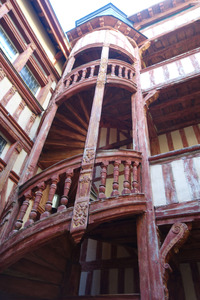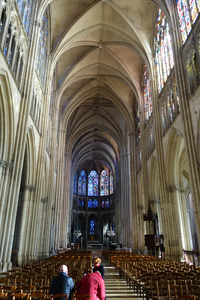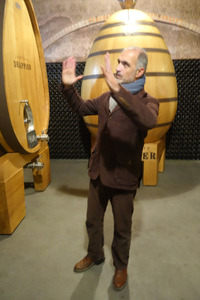Champagne wasn’t so much as a gleam in a winemaker’s eye when the Knights Templar met their demise, yet in the vineyard cellars of the French Aube region its connections with the crusading order quickly become apparent.
 The thread starts with Hugues de Payns, a Knight born in the village near the city of Troyes that bears his surname. In Payns there is a museum and the remains of a commanderie – or Templar base – that he founded. After the First Crusade he had badgered the King of Jerusalem to sanction the creation of a monastic order of Knights that would protect pilgrims travelling to the Holy Land. The King granted the order headquarters on the Temple Mount. Hence their name.
The thread starts with Hugues de Payns, a Knight born in the village near the city of Troyes that bears his surname. In Payns there is a museum and the remains of a commanderie – or Templar base – that he founded. After the First Crusade he had badgered the King of Jerusalem to sanction the creation of a monastic order of Knights that would protect pilgrims travelling to the Holy Land. The King granted the order headquarters on the Temple Mount. Hence their name.
The web of links widens with Bernard of Clairveaux – later St. Bernard – who set out rules for the Knights in 1128. These regulations were pretty proscriptive: among them obedience, modest living, no sex and no excessive boozing. They were to comport themselves, in other words, as did Chaucer’s “verray, parfit gentil Knyght”.
Being a Cistercian, Bernard no doubt practiced what he preached. He was said to have hurled himself into icy water to control his lust. But that didn’t stop him raising money for his abbey by planting Pinot Noir vines. According to Michel Drappier, head of the Champagne house Drappier, he wanted to produce a red wine to rival those produced by monks in Burgundy. Pinot Noir became the dominant grape in Champagne production.
Whether or not revenues from the sale of that red wine found their way into the Templars’ soon to be groaning coffers isn’t known. At Clairveaux Abbey, founded by Bernard and overlooked by his hilltop statue, they will tell you the order didn’t benefit from any of the monastery’s largesse. Aside from the beautifully restored monks’ refectory with its elegant, early Gothic vaulting – now used for the occasional concert – it’s a bleak place with little to remind you of the influence it once wielded. Blame Napoleon. He turned the abbey into a prison. Victor Hugo used it as the basis for a short story, Claude Gueux, an attack on 19th century judicial retribution that he expanded on in Les Miserables. At that time there was no glass in the windows. Other inmates have included the resistance hero Guy Moquet, Jacques Mesrine, the criminal seen as a latter day Robin Hood, who was the subject of a two part film – and Carlos the Jackal. You can see the grimly fascinating cages a poules (chicken coups), wood and metal hutches that served as cells until 1971. A prison remains part of the sprawling abbey complex. It is earmarked for closure but meanwhile visitors must handover their passports before entering the abbey confines and are forbidden to take photographs.
The Templar connection also leads you to Avalleur, another of the order’s commanderies – in this case run by its non military wing, who farmed to ensure the Knights received finance, horses, food and arms for their campaigns in the Holy Land and against the Moors in Spain. In the chapel is a stone found in the nearby forest, its carved emblems indicating that it marked the border of their territory with that of the King.
 It was in the original, Romanesque, Cathedral of St Peter and St Paul, in the Aube capital, Troyes, that a council of Bishops and delegates from Rome approved the establishment of the order and its rules. The rebuilt cathedral’s treasures includes a reliquary of St Bernard – ironic in view of his recorded tirade against those who allowed their veneration or such riches to divert them from the truly sacred. It also contains plunder from the sacking of Constantinople during the Fourth Crusade, including a casket owned by a Byzantine emperor. Logic suggests it was brought back by a Templar, though it’s not thought the Knights played a major part in the plunder.
It was in the original, Romanesque, Cathedral of St Peter and St Paul, in the Aube capital, Troyes, that a council of Bishops and delegates from Rome approved the establishment of the order and its rules. The rebuilt cathedral’s treasures includes a reliquary of St Bernard – ironic in view of his recorded tirade against those who allowed their veneration or such riches to divert them from the truly sacred. It also contains plunder from the sacking of Constantinople during the Fourth Crusade, including a casket owned by a Byzantine emperor. Logic suggests it was brought back by a Templar, though it’s not thought the Knights played a major part in the plunder.
They owned property in Troyes, establishing their Champagne region commanderie on a street called the Rue du Temple for seven centuries until 1906, when it became The Rue General Saussier. It is now the site of a Catholic school. On the Rue des Changes the Templars issued credit notes to travellers who would need readies when they reached Jerusalem.
Troyes is a feast for the eyes. Ravaged by fire in the 16th century, it has a large number of half timbered houses built in the aftermath. There are so many you don’t need to go out of your way to see them, though some are closeted in courtyards, such as the Hotel du Lion, with its external, spiral staircase.
But lovely though the city may be, it is in the vineyards that the continuity of history really comes home, in the realization that vines were tended there before the crusades and long after the Templars’ fell from grace amid dubious accusations of heresy, corruption and sodomy. The second fermentation that produces Champagne wasn’t used until the 17th century.
 At Monial and at Drappier, both of which have Cistercian cellars. For one of his cuvees Michel Drappier uses the Arbane, a grape thought to have been brought by the Romans which ‘has disappeared everywhere else on the planet’. His great, great, great grandfather first settled in the village of Urville in 1808 but, France being at war, had to sell his wine to merchants in Epernay. His grandfather acquired the cellars, which had been built at the behest of Bernard of Clairveaux. It wasn’t until 1951, after a half century that had seen production and sales hit by philloxera, the Great Depression and two World Wars, that Michel’s father really got the business going.
At Monial and at Drappier, both of which have Cistercian cellars. For one of his cuvees Michel Drappier uses the Arbane, a grape thought to have been brought by the Romans which ‘has disappeared everywhere else on the planet’. His great, great, great grandfather first settled in the village of Urville in 1808 but, France being at war, had to sell his wine to merchants in Epernay. His grandfather acquired the cellars, which had been built at the behest of Bernard of Clairveaux. It wasn’t until 1951, after a half century that had seen production and sales hit by philloxera, the Great Depression and two World Wars, that Michel’s father really got the business going.
Today Drappier employs modern, eco friendly methods. By next year it aims to be 70% solar powered. Michel has been experimenting with curious, egg shaped barrels.
But the oak for some barrels still comes from the Templars’ forest. Sipping La Grande Sendree (the cuvee, made from grapes grown on a patch of Drappier terroir fertilized by ash from an 1838 woodland fire, was misnamed. It should have been spelled with a c as in cinders) you might wonder what the Knights would have made of it.
They might have had serious difficulty toeing the line. One if the 70 odd rules governing their behavior – and demanding moderation – quoted Solomon: “wine corrupts the wise”.
More information
www.monial.net (Champagne Monial)











